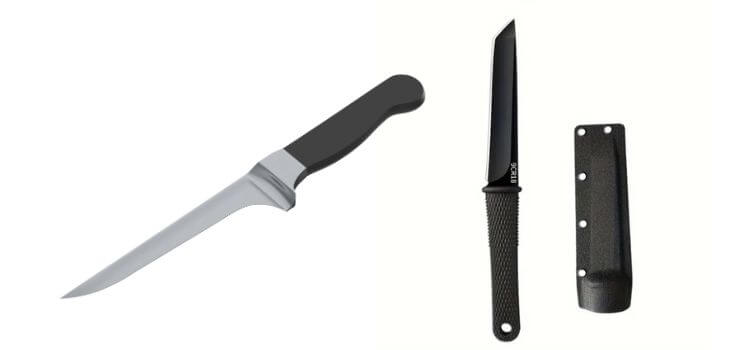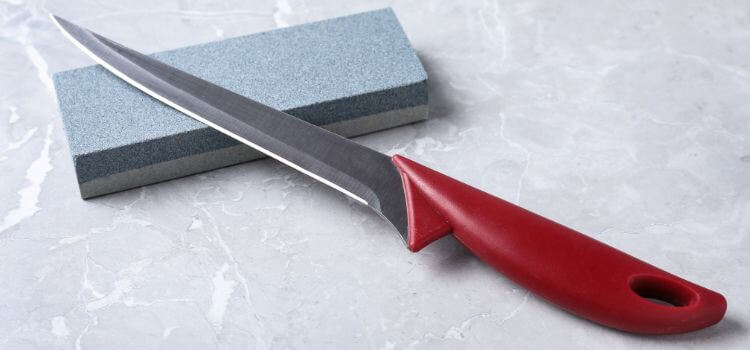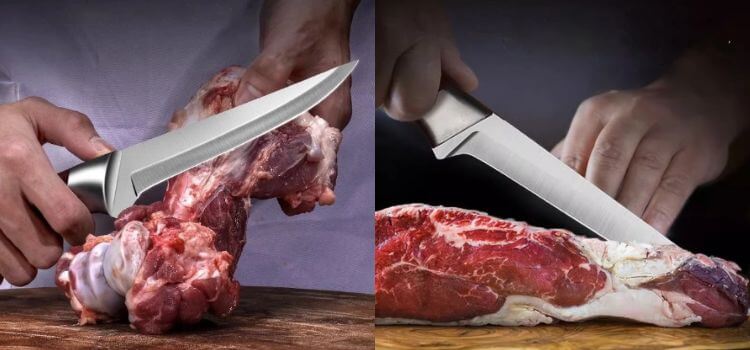As an Amazon Associate, I earn from qualifying purchases

When it comes to mastering the art of butchery or filleting, the debate between curved and straight boning knives has long been a point of contention among culinary enthusiasts. This article explores the subtle yet meaningful distinctions between these two types of knives, exploring their unique advantages and applications in the kitchen.
Whether you’re an experienced chef or an enthusiastic home cook, understanding the nuances of curved versus straight boning knives can elevate your knife skills to the next level. Join us as we slice through the details and help you decide which blade best suits your cutting needs.
Understanding Boning Knives

Before we dive into the differences between curved and straight boning knives, it’s important to understand what a boning knife is and its purpose in the kitchen. Boning knives are specialized knives primarily used to remove bones from meat, poultry, and fish.
They typically have a thin, sharp blade with a pointed tip and a flexible or stiff spine. The sharpness and precision of a boning knife’s blade make it ideal for navigating around bones and joints, allowing for clean and accurate cuts.
Differentiating between curved and straight blade designs
The main difference between curved and straight boning knives is their design. As the name suggests, a curved boning knife has a slightly curved or arched blade resembling the shape of a sickle or scimitar. On the other hand, a straight boning knife has a blade that is completely straight from tip to handle.
Curved Boning Knife
The curved blade of a boning knife follows the natural curve of the animal’s bones, making it easier to maneuver and separate meat from bone. The shape also allows for better control and precision when cutting around joints or tight areas. This makes it an ideal tool for delicate tasks such as deboning fish or poultry.
Pros and Cons of a Curved Boning Knife
Pros:
- Better maneuverability and control when cutting around bones and joints.
- Easier to achieve precise cuts, especially in tight areas.
- It can be used for tasks beyond just boning, such as slicing or trimming fat.
Cons:
- The blade’s curve can make it more difficult to sharpen and maintain.
- It may not be as versatile as a straight boning knife for other kitchen tasks.
Straight Boning Knife
A straight boning knife, with its completely straight blade, offers different advantages and disadvantages compared to its curved counterpart. The lack of a curve allows for more control and stability when cutting through meat, making it the go-to choice for tougher cuts of meat or larger animals.
Pros and Cons of a Straight Boning Knife
Pros:
- Better precision and stability when working with tough cuts of meat or larger animals.
- Easier to sharpen and maintain due to the straight blade.
- It can be used for a variety of tasks beyond just boning, such as slicing and carving.
Cons:
- It may be less effective in tight spaces or when working around joints.
- The lack of a curve can make it more challenging to maneuver and control the knife.
A Comparison: Curved vs Straight Boning Knife

Both curved and straight boning knives have their unique strengths and weaknesses. Ultimately, the decision between the two hinges on personal preference and the types of cutting tasks you frequently face in your kitchen.
- If precision is crucial, especially when working with small or delicate cuts of meat, a curved boning knife may be the better option.
- For larger or tougher cuts of meat, a straight boning knife offers more control and stability.
- If you’re looking for a versatile knife that can serve multiple purposes beyond just boning, a straight boning knife may be the better choice.
Choosing the Right Knife for Your Needs
Factors to consider when deciding between a curved and straight boning knife:
- Type of meat: Consider the size and tenderness of the meat you commonly work with.
- Cutting tasks: Think about the types of cuts you need to make and which knife would be more effective for those tasks.
- Personal preference: Ultimately, your comfort and ease of use with a certain type of knife should also play a role in your decision.
Practical tips for selecting the ideal knife based on your cutting requirements:
- If you frequently debone fish or poultry, a curved boning knife may be the better choice due to its precision and maneuverability.
- For tougher cuts of meat or larger animals, a straight boning knife will provide more stability and control.
- Consider investing in both knives to have on hand for different cutting tasks.
Conclusion
In summary, understanding the differences between curved and straight boning knives is crucial for any culinary enthusiast looking to up their kitchen game. While both have distinct advantages and disadvantages, it ultimately comes down to personal preference, and the type of cutting tasks you most often encounter in your kitchen.
Armed with this knowledge, you can confidently choose the perfect knife to meet your specific needs and elevate your knife skills to the next level. Happy cutting!
As an Amazon Associate, I earn from qualifying purchases
Pingback: Boning vs Fillet Knife